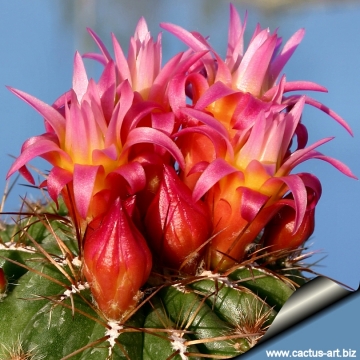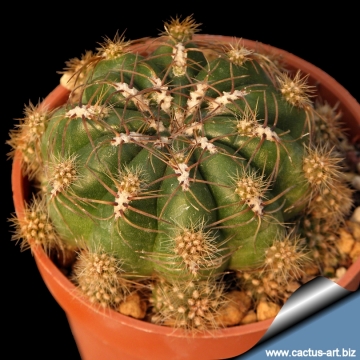= Oroya peruviana var. minima Kníže
n.n.
Accepted Scientific Name: Oroya peruviana Britton & Rose
3: 102. 1922 [12 Oct 1922]

Oroya peruviana caespitosa (Oroya peruviana var. minima) Photo by: Valentino Vallicelli
The flowers are small pink with a yellowish centres, in dense clusters at the plant apex and open in the summer.
Origin and Habitat: The var. "minima" (caespitosa) is a name that has appeared in some lists of seeds, but is not validly recognized by botanists.
Synonyms:
See all synonyms of Oroya peruviana
back
Accepted name in llifle Database:Oroya peruviana Britton & Rose3: 102. 1922 [12 Oct 1922]Synonymy: 28
back
Description: Oroya peruvianaSN|1494]]SN|1494]] is a very variable species, with a (usually) solitary slow-growing flattened stem, that eventually becomes shortly columnar, up to 20 cm in diameter, 30 cm tall.
On the contrary the var. minima offsets strongly in almost on each basal node of the stem on top of the ribs, with even small heads covered with numerous pups reaching only 2-5 cm across. In age forms clump up to 15 cm in diameter with up to 100 heads (or more), and generally the single heads stay smaller than the type. The spines are more or less pectinated, and range in colour from pale yellow to brown. They are relatively long, and widely spaced.
The flowers are small and pink with yellowish centres, in dense clusters at the plant apexes and open in the summer, sometimes in a ring.. They are followed by red, hollow berries.
More...Subspecies, varieties, forms and cultivars of plants belonging to the Oroya peruviana group
 Oroya peruviana Britton & Rose: is a variable species with (usually) solitary slow-growing flattened stem up to 20 cm in diameter. The spines are also variable, more or less pectinated and range in colour from pale yellow to brown.
Oroya peruviana Britton & Rose: is a variable species with (usually) solitary slow-growing flattened stem up to 20 cm in diameter. The spines are also variable, more or less pectinated and range in colour from pale yellow to brown. Oroya peruviana f. cristata hort.: crested form. Garden origin (Nursery produced cultivar)
Oroya peruviana f. cristata hort.: crested form. Garden origin (Nursery produced cultivar) Oroya peruviana var. depressa (Rauh & Backeb.) Rauh & Backeb. in Rauh: has very flattened (depressed) stem, growing slowly to 20 cm. across. Diastribution: Apurimac region (Totorabamba, Andahuaylas, Kishuara), Peru.
Oroya peruviana var. depressa (Rauh & Backeb.) Rauh & Backeb. in Rauh: has very flattened (depressed) stem, growing slowly to 20 cm. across. Diastribution: Apurimac region (Totorabamba, Andahuaylas, Kishuara), Peru. Oroya peruviana var. gibbosa F.Ritter: Plant with few spines and ribs notched and forming noticeable tubercles.
Oroya peruviana var. gibbosa F.Ritter: Plant with few spines and ribs notched and forming noticeable tubercles. Oroya peruviana var. minima Kníže: it is a freely offseting clone known in cultivation only. In age forms clump up to 15 cm in diameter with up to 100 heads (or more).
Oroya peruviana var. minima Kníže: it is a freely offseting clone known in cultivation only. In age forms clump up to 15 cm in diameter with up to 100 heads (or more). Oroya peruviana var. neoperuviana (Backeb.) Slaba: Up to about 40 cm. tall and 25 cm. wide, with 24-40 ribs, spines pectinated, yellowish to straw-yellow. Flowers orange-red, produced in a ring around the crown of the plant in spring.
Oroya peruviana var. neoperuviana (Backeb.) Slaba: Up to about 40 cm. tall and 25 cm. wide, with 24-40 ribs, spines pectinated, yellowish to straw-yellow. Flowers orange-red, produced in a ring around the crown of the plant in spring.
 Oroya peruviana caespitosa (Oroya peruviana var. minima) Photo by: Cactus Art
Oroya peruviana caespitosa (Oroya peruviana var. minima) Photo by: Cactus Art Oroya peruviana caespitosa (Oroya peruviana var. minima) Photo by: Cactus Art
Oroya peruviana caespitosa (Oroya peruviana var. minima) Photo by: Cactus Art Oroya peruviana caespitosa (Oroya peruviana var. minima) Photo by: Cactus Art
Oroya peruviana caespitosa (Oroya peruviana var. minima) Photo by: Cactus ArtSend a photo of this plant.The gallery now contains thousands of pictures, however it is possible to do even more. We are, of course, seeking photos of species not yet shown in the gallery but not only that, we are also looking for better pictures than those already present.
Read More... Cultivation and Propagation: It is a summer grower species that offers no cultivation difficulties. Water regularly in summer (but do not overwater ) keep dry in winter. Feed with a high potassium fertilizer in summer. Repot yearly until reaching about 100 mm in size, then every two or three years will suffice. Repotting is best done at the end of winter but can be done at other times. Do not water for a couple of weeks after repotting to reduce risk of root rot via broken roots. Repotting will increase size of stems. This species needs a minimum temperature of 5° C. It will form ugly scars if exposed to too much cold, but it can survive a minimum temperature of – 7°C. Need a bright exposure, full sun or half shade in summer.
Propagation: Seed, grafting, cutting.













